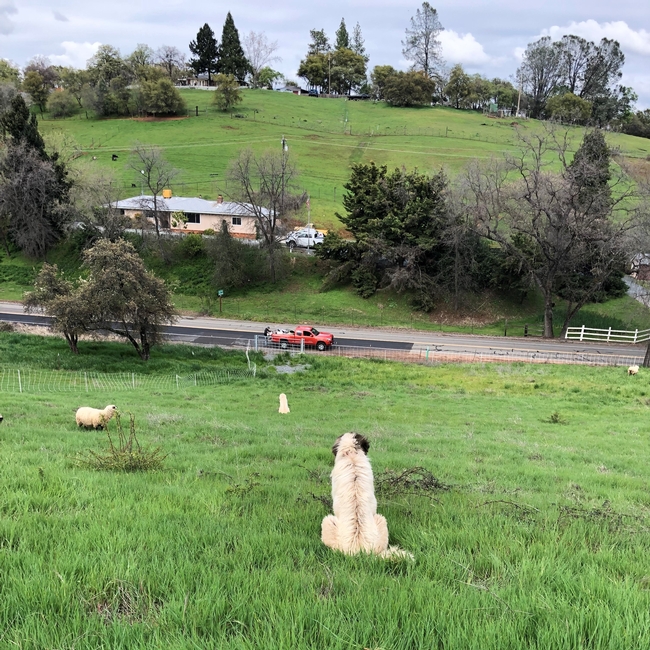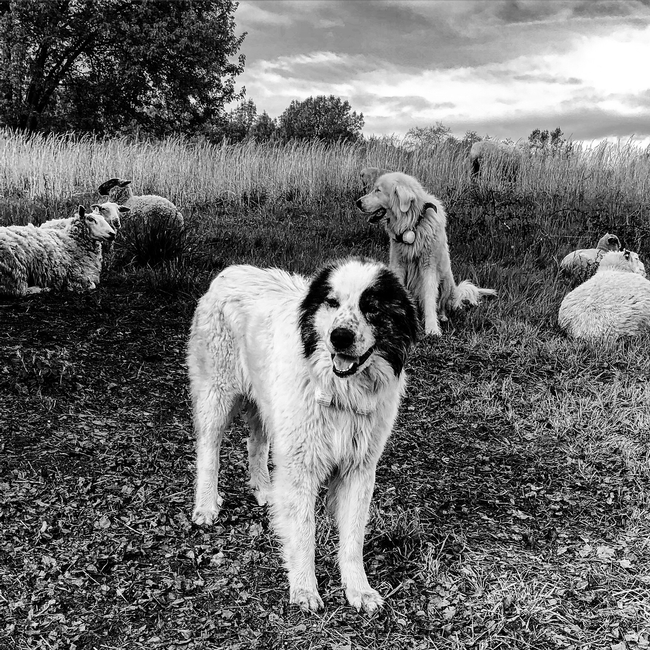I realized this morning that it's been some time (nearly a year, in fact) since I posted an update on my progress with our youngest livestock guardian dog, Elko. In case you missed the first five installments of this journal, Elko is a Pyr x Akbash dog we acquired from Fred Groverman in Petaluma in September 2017. I've been tracking our progress in his development. This weekend marked a significant step in Elko's development.
During the last week of March, I traveled through northeastern California talking about (and more importantly, learning about) protecting livestock from predators. Thanks to a Renewable Resources Extension Act grant, a number of my UC Cooperative Extension colleagues and I were able to bring some folks with experience dealing with wolves and grizzly bears in Wyoming and Montana to share their perspectives with California ranchers. During our formal workshops - and during the 700+ miles we traveled together - I learned a tremendous amount!
George Edwards is the executive director of the Montana Livestock Loss Board, a state program that compensates ranchers for losses to wolves, mountain lions, and grizzly bears. George provided invaluable insights into why a compensation program makes sense - and into the types of tools that ranchers are using in Montana to avoid these losses. He shared this outstanding video about an innovative carcass disposal program in western Montana.
I first met Cat Urbigkit nearly 10 years ago at an American Sheep Industry conference in Reno. I've since had the chance to get to know Cat as a fellow producer and friend. Her experiences using livestock guardian dogs to protect both sheep and cattle from large carnivores - including gray wolves and grizzlies - was especially enlightening.
Now that I've had a few weeks to reflect on what I learned, my own experiences with livestock guardian dogs have come into clearer focus. Cat emphasized that no two dogs are alike - just as no two livestock operations are alike. A dog that will work for Cat in western Wyoming may not be a good fit for me in the foothills of the Sierra Nevada; similarly, my dogs may not work well in Cat's extensive rangeland environment. In other words, a dog "trained" by someone else - that is, bonded with someone else's livestock in their environment - won't necessarily stay with my sheep. I have not been successful in outsourcing the critical bonding period. My dogs have to bond with my sheep.
Livestock guardian dogs, as Cat says, are "dogs of nature." Rather than "training" them, we must give them the opportunity to fully express their own instincts. They should smell, hear, and see the livestock they'll spend their lives protecting from the earliest possible moment. I've written previously that I think this means that my dogs need to bond with my sheep and my system (electric fenced paddocks in the urban-rural interface). I think that's not quite right, however. After visiting with Cat, I think the bond between dog and my sheep is the most critical component. My dogs stay with my sheep because of their bond - not because of my fence. The dogs I used early in my shepherding career roamed because I hadn't allowed them to bond properly, I suspect. And this bonding process has to happen on my operation - a livestock guardian dog "specialist" who isn't also a rancher can't duplicate my specific conditions.
Elko spent last summer with our dry ewes in the company of another LGD, Bodie. When we split our sheep into separate breeding groups in late September, Elko (who was then just over a year old) went with his own group of ewes. About a week into our breeding season, we suspect we lost a ewe in Bodie's group to a coyote attack (in a paddock with low visibility due to vegetation). We put Elko with Bodie at that point, with good results. Bodie, who we know we can trust with lambing ewes, stayed with the ewes through the winter and during lambing. Once we separated the rams from the ewes in mid-November, Elko stayed with the rams until this past Saturday. The rams went home to be shorn; the ewes and lambs went to irrigated pasture - and Elko joined Bodie as part of his "final exam."
Last year, we put Bodie with an older dog at the beginning of lambing season (here's a video link). The older dog, Reno, chased Bodie away from lambing ewes, which helped Bodie understand what was expected of him. By coincidence, our last ewe lambed on Saturday shortly after we put Elko with Bodie and the ewe flock - and I observed Bodie provide similar training. Bodie would not let Elko get too close to the ewe and her new lambs. I suspect that this was at least partly because Bodie wanted to eat the afterbirth; regardless, the result was that Elko learned to respect a lambing ewe's "personal space."
Elko's training is not completed - he's still in the canine equivalent of his late teen years. At the risk of anthropomorphizing our LGDs, I know that I didn't always make the best decisions in my late teen years - we'll keep a close eye on Elko while he's with the lambs and ewes. That said, this weekend he passed a significant test!
A final note on costs - Elko cost us $525.35 to acquire (cost of puppy + mileage). Through Saturday, we've spent $526.44 on vaccinations and dog food.
Also - here's a link to a new fact sheet on LGDs we developed as part of our grant-funded project.
